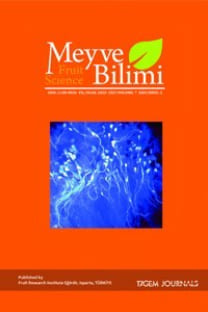Portakal YaÄÄąnÄąn YeÅil Åeftali Yaprak Biti [(Myzus persicae Sulzer) (Hemiptera: Aphididae)] Populasyonu Ãzerine Etkisi
D-limonen, terpenoidler, bitki sekonder metabolitleri, biyoinsektisit, uçucu yaÄlar
The Effects of Orange Oil to Population of Green Peach Aphid [(Myzus persicae Sulzer) (Hemiptera: Aphididae)]
D-limonene, terpenoids, plant secondary metabolites, bioinsecticide, essential oils,
___
- AkkÃķprÞ EP, 2021. VermisÞspansiyon uygulamalarÄąnÄąn biber (Capsicum annum L. Solanaceae) Þzerinde beslenen YeÅil Åeftali yaprakbiti [(Myzus (N.) persicae Sulzer)(Hemiptera: Aphididae)]ânin popÞlasyon geliÅimi Þzerine etkileri. Plant Protection Bulletin, 61(1): 49-59. Doi: 10.16955/bitkorb.753214.
- Ahmed Q, Agarwal M, Al-Obaidi R, Wang P, Ren Y, 2021. Evaluation of aphicidal effect of essential oils and their synergistic effect against M. persicae (Sulzer)(Hemiptera: Aphididae). Molecules, 26(10): 3055. Doi: 10.3390/molecules26103055.
- Al-Antary TM, Ateyyat MA, Belghasem IH, Alaraj SA, 2018. Aphicidal activity of orange oil to the green peach aphid M. persicae sulzer (Homoptera: Aphididae). Fresenius Environmental Bulletin, 27(20): 1038-1042.
- Alotaibi SS, Darwish H, Alzahrani AK, Alharthi S, Alghamdi AS, Al-Barty AM, Noureldeen A, 2022. Environment-Friendly Control Potential of Two Citrus Essential Oils against Aphis punicae and Aphis illinoisensis (Hemiptera: Aphididae). Agronomy, 12(9): 2040. Â https://doi.org/10.3390/agronomy12092040.
- Ay R, YaÅar B, DemirÃķzer O, Aslan B, Yorulmaz S, Kaya M, Karaca Ä°, 2007. Isparta Ä°li elma bahçelerinde yaygÄąn kullanÄąlan bazÄą ilaçlarÄąn kalÄąntÄą dÞzeylerinin belirlenmesi. Turkish Journal of Entomology, 31(4): 297-306.
- Beatty JH, 1986. Limonene-A natural insecticide. Journal of Chemical Education, 63(9): 768.
- Chandler D, Bailey AS, Tatchell GM, Davidson G, Greaves J, Grant WP, 2011. The development, regulation and use of biopesticides for integrated pest management. Philosophical Transactions of the Royal Society B: Biological Sciences, 366(1573), 1987-1998. doi: 10.1098/rstb.2010.0390.
- ErdoÄan P, YÄąldÄąrÄąm A, 2016. Insecticidal activity of three different plant extracts on the green peach aphid [(M. persicae Sulzer)(Hemiptera: Aphididae)]. Journal of the entomological research society, 18(1): 27-35.
- ErgÞn G, AktaÅ S, 2009. ANOVA modellerinde kareler toplamÄą yÃķntemlerinin karÅÄąlaÅtÄąrÄąlmasÄą. Kafkas Univ Vet Fak Derg, 15 (3): 481-484.
- Fenibo EO, Ijoma GN, Matambo T, 2021. Biopesticides in sustainable agriculture: A critical sustainable development driver governed by green chemistry principles. Frontiers in Sustainable Food Systems, 141. doi:https://doi.org/10.3389/fsufs.2021.619058.
- Gavahian M, Chu YH, Mousavi Khaneghah A, 2019. Recent advances in orange oil extraction: An opportunity for the valorisation of orange peel waste a review. International Journal of Food Science & Technology, 54(4): 925-932. doi: https://doi.org/10.1111/ijfs.13987
- Henderson CF, Tilton EW, 1955. Tests with acaricides against the brown wheat mite. J Econ Entomol, 48: 157-161. https://doi.org/10.1093/jee/48.2.157.
- Isman MB, 2020. Botanical insecticides in the twenty-first centuryâfulfilling their promise?. Annual Review of Entomology, 65: 233-249. doi:Â 10.1146/annurev-ento-011019-025010.
- John I, Muthukumar K, Arunagiri A, 2017. A review on the potential of citrus waste for D-Limonene, pectin, and bioethanol production. International Journal of Green Energy, 14(7): 599-612. doi: https://doi.org/10.1080/15435075.2017.1307753
- Karr L, Coats JR, 1988. Insecticidal properties of D-limonene. J. Pestic. Sci. 13: 287â290.
- Karsavuran Y, Ãzge Anaç. M. persicae Sulzer (Hemiptera: Aphididae)'nin Biyolojisine Ana YaÅÄąnÄąn Etkileri Ãzerinde AraÅtÄąrmalar. Ege Ãniversitesi Ziraat FakÞltesi Dergisi, 51(2): 153-163. doi: https://doi.org/10.20289/euzfd.99903
- Lodos N, 1986. TÞrkiye Entomolojisi (Genel, UygulamalÄą ve Faunistik), Cilt II (GÃķzden geçirilmiÅ II. BasÄąm). Ege Ãniversitesi Ziraat FakÞltesi YayÄąnlarÄą No. 429, 580s.
- Metcalfe, JL, 1989. Biological water quality assessment of running waters based on macroinvertebrate communities: history and present status in Europe. Environmental pollution, 60(1-2): 101-139. Doi:10.1016/0269-7491(89)90223-6
- Ãzdemir SN, Salman SY, 2021. Relationship Between Resistance Against Neonicotinoids and Esterase Enzyme for Myzus persicae (Sulzer)(Hemiptera: Aphididae) Populations in South of Turkey. Journal of Agricultural Sciences, 27(1): 26-31. Doi: https://doi.org/10.15832/ankutbd.593222
- Pavela R, Benelli G, 2016. Essential oils as ecofriendly biopesticides? Challenges and constraints. Trends in plant science, 21(12): 1000-1007.
- Riedle-Bauer M, Bauer H, MÃķrtel J, 2011. Effects of possible repellents on feeding and survival of Cacopsylla pruni (Scopoli). Bulletin of Insectology, 64: 263-264.
- Sciortino M, Scurria A, Lino C, Pagliaro M, D'Agostino F, Tortorici S, Ciriminna R, 2021. SilicaâMicroencapsulated Orange Oil for Sustainable Pest Control. Advanced Sustainable Systems, 5(4): 2000280. doi:Â https://doi.org/10.1002/adsu.202000280.
- Smith GH, Roberts JM, Pope TW, 2018. Terpene based biopesticides as potential alternatives to synthetic insecticides for control of aphid pests on protected ornamentals. Crop Protection, 110: 125-130. doi: https://doi.org/10.1016/j.cropro.2018.04.011.
- SPSSÂŪ for Windows: Rel. 15.0.0. Chicago: SPSS Inc, 2006.
- Sun J, 2007 D-limonene: Safety and clinical applications. Altern Med Rev 12: 259-264.
- Ãlger TG, Ayhan NY, 2020. Bitki Sekonder Metabolitlerinin SaÄlÄąk Ãzerine Fonksiyonel Etkileri. AcÄąbadem Ãniversitesi SaÄlÄąk Bilimleri Dergisi, (3): 384-390. https://doi.org/10.31067/0.2020.288.
- Ãnal MÃ, Ucan F, Åener A, Dincer S, 2012. Research on antifungal and inhibitory effects of DL-limonene on some yeasts. Turkish Journal of Agriculture and Forestry, 36(5): 576-582. doi:10.3906/tar-1104-41.
- ISSN: 2148-0036
- BaÅlangÄąÃ§: 2013
- YayÄąncÄą: Meyvecilik AraÅtÄąrma EnstitÞsÞ MÞdÞrlÞÄÞ
TÞrkiye'nin Meyve DÄąÅ Ticaretini Etkileyen FaktÃķrler: Bir Ãekim Modeli YaklaÅÄąmÄą
Stratejik Planlamada âStratejik YÃķnelim Turu-SORâ Analizi YaklaÅÄąmÄą
Dilek KARAMÃRSEL, Fatma ÃZTÃRK
In Vitro KoÅullarda FarklÄą Poliamin UygulamalarÄąnÄąn Ãilekte Tuzluluk Stresi Ãzerine Etkileri
Eda Elif YAVUZLAR, Nafiye ÃNAL
Mehmet Sedat SEVÄ°NÃ, Murat YEÅÄ°LIRMAK, Nuran KARATAÄ, Burcu YAMAN, Melike ÃETÄ°NBAÅ, Ä°rfan NAZLI
